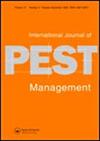Effect of Avena strigosa straw and rainfall on sulfentrazone and flumioxazin control effectiveness of Amaranthus spp.
IF 1.1
4区 农林科学
Q3 ENTOMOLOGY
引用次数: 1
Abstract
Abstract Cover crops constitute an interesting option for cultural weed control. Expansion of herbicide resistant weeds in Uruguay, has been associated with an increase use of pre-emergent herbicides for their control. Crops residues could decrease their effectiveness. The objective of these work was to evaluate the effect of Avena strigosa straw and moment and amount of rain, in Amaranthus spp. control effectiveness by flumioxazin and sulfentrazone. Two experiments were carried out for each herbicide in pots, in a greenhouse. The design was in randomized complete blocks, with five repetitions and factorial arrangement of treatments. In experiments I, factors were: I) amount of A. strigosa straw (0 and 6 t ha−1); and II) amount of rainfall (20 and 80 mm), for each herbicide. In experiments II, factors were: I) amount of A. strigosa straw (0 and 6 t ha−1); II) amount of rainfall (20, 60 mm); and III) Days between application and rainfall occurrence (1, 7 and 14). Weed emergencies were quantified at days 8, 22 and 39 after rainfall (DAR). Results were independently analyzed using a model with gaussian distribution. Sulfentrazone effectiveness in Amaranthus spp. control was not affected by studied factors. In the case of flumioxazin, straw effect was consistently detected. Amounts of 6 t ha−1 of oat straw reduced Amaranthus spp. control effectiveness of the herbicide.燕麦秸秆和降雨量对亚磺甲唑酮和氟米奥嗪防治苋属植物效果的影响。
覆盖作物是一种有效的杂草防治方法。在乌拉圭,抗除草剂杂草的扩大与增加使用发芽前除草剂来控制杂草有关。作物残茬会降低其有效性。本研究的目的是评价曲麦草秸秆和降雨时间、降雨量、氟恶嗪和磺胺酮对苋属植物的防治效果。每种除草剂在温室的花盆中进行了两次试验。设计采用随机完全块,5次重复和治疗的阶乘安排。试验1中,影响因素为:1)藻单胞菌秸秆用量(0和6 t / h - 1);和II)降雨量(20和80毫米),每种除草剂。试验二的影响因素为:1)藻单胞菌秸秆用量(0和6 t / h - 1);II)降雨量(20、60毫米);III)施药与降雨之间的天数(1,7和14)。在降雨后第8、22和39天对杂草突发事件进行量化。结果采用高斯分布模型进行独立分析。磺胺酮对苋属植物的防治效果不受影响。氟咪唑嗪的稻草效应持续存在。6 t / hm2的燕麦秸秆用量降低了该除草剂对苋属植物的防治效果。
本文章由计算机程序翻译,如有差异,请以英文原文为准。
求助全文
约1分钟内获得全文
求助全文
来源期刊
CiteScore
4.70
自引率
6.70%
发文量
74
审稿时长
>12 weeks
期刊介绍:
International Journal of Pest Management publishes original research papers and reviews concerned with pest management in the broad sense, covering the control of pests (invertebrates, vertebrates and weeds) and diseases of plants, fungi and their products – including biological control, varietal and cultural control, chemical controland interference methods.
The management of invasive species is of special interest. We also encourage submissions dealing with interactions of multiple pests such as arthropods and plant pathogens, pathogens and weeds or weeds and arthropods as well as those dealing with the indirect and direct effects of climate change on sustainable agricultural practices.

 求助内容:
求助内容: 应助结果提醒方式:
应助结果提醒方式:


